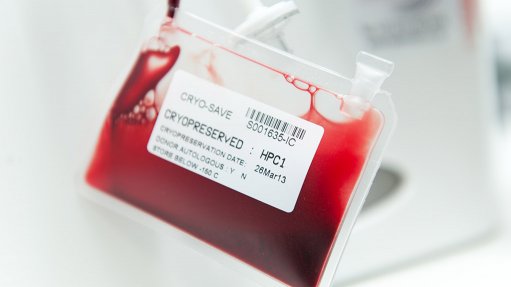
UMBILICAL BLOOD STEM CELLS Potent stem cells can be harvested from the placenta and umbilical cord that are usually discarded as medical waste, despite being full of potent stem cells
Stored haemopoietic stem cells drawn from the umbilical cord are currently being used to treat 70 diseases, including leukaemia and sickle-cell anaemia. However, these stem cells and other placental tissue cells may be used to treat many diverse diseases and health conditions in future.
This is according to JSE-listed private equity and financial services group Ecsponent CEO Terence Gregory. Ecsponent invested in South African biotechnology firm Lazaron Biotechnology, which evolved to become the Cryo-Save South Africa business, a joint venture between Ecsponent and Cryo-Save international.
The stored stem cells are used to treat only the child whose umbilical cord blood and umbilical cord tissue were gathered or, in rare cases, to treat a relative who has closely matching genes. A specialised kit is given to parents and hospitals, with doctors using it to obtain the cells immediately after birth.
Stem cells are pluripotent – they can become many different types of cells and then be used to cultivate more such cells – and, since they derive from the person being treated, the problems of host rejection and graft rejection are reduced significantly.
Embryonic placental stem cells are also called naïve cells, as they have not had any exposure to diseases, stress or infections and are effective at differentiating into various healthy cell types that might be used to treat a range of medical conditions.
“Our storage techniques and laboratory protocols derive from the international Cryo-Save business, which is the largest family stem-cell bank in Europe. Our storage is insulated from any power failures and we can run for 20 years or more without power, as long as there is a supply of liquid nitrogen.
“All the samples are processed before storage, which typically involves a centrifuge to separate the specific cells from the blood and a type of noninvasive antifreeze applied to blood and tissue so that the cells do not burst during preservation. The cells are gradually cooled down and then kept at –196 ºC. Technical quality assurance and control expertise derive from Cryo-Save protocols,” explains Gregory.
“Parents have only one chance to have these stem cells stored, and that is right after birth. However, except in some cultures, the placenta and umbilical cord are discarded as medical waste, despite being full of pure and potent stem cells.”
All doctors can give advice to patients on the value of stem-cell storage. Hospitals only store a small number of kits, just in case the parents on the day of delivery forget their kit. Once a new person signs up with Cryo-Save a kit is delivered to them.
The investment in the biotechnology subsidiary is in line with Ecsponent’s investment strategy to acquire interests and develop businesses with high intellectual property and high barriers to entry.
“The venture is an example of the success of combining Cryo-Save’s technical excellence with Ecsponent’s capital provision, marketing and local business expertise,” concludes Gregory.